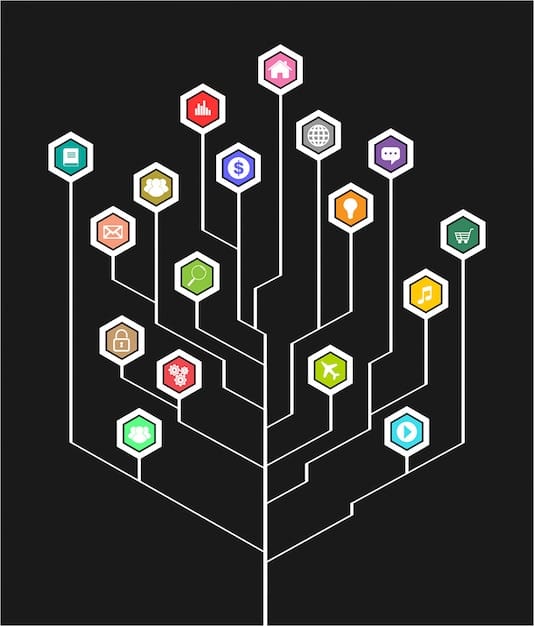Will Decentralized Social Media Dominate the US by 2026?

Decentralized social media platforms aim to disrupt traditional platforms by offering users greater control over their data and content; however, their adoption in the US by 2026 will depend on factors like user experience, scalability, and regulatory acceptance.
The rise of blockchain technology has sparked interest in decentralized alternatives to conventional social media giants. Can decentralized social media overtake traditional platforms in the US by 2026? This article explores the potential for this shift, examining the advantages and challenges decentralized platforms face in gaining mainstream adoption.
Understanding Decentralized Social Media
Decentralized social media represents a departure from the centralized model typified by platforms like Facebook, Twitter, and Instagram. These traditional platforms store user data on their servers, wielding significant control over content and user privacy. Decentralized alternatives seek to distribute this control back to the users.
These platforms leverage blockchain technology, P2P networks, and other distributed ledger technologies to create a more democratic, transparent, and user-centric online experience. The core principle is to eliminate single points of failure and control, ensuring more resilient and censorship-resistant social networks.
Key Characteristics of Decentralized Social Media
Decentralized social media platforms share several common characteristics:
- Data Ownership: Users have complete control over their data and can choose who has access to it.
- Censorship Resistance: Elimination of centralized control reduces the likelihood of censorship or arbitrary content moderation.
- Transparency: Blockchain technology ensures transparency in data storage and transactions.
- Monetization Opportunities: Users may have opportunities to monetize their content directly, without relying on platform-mediated advertising.
Decentralized platforms also offer enhanced security and privacy features, which are increasingly important to users concerned about data breaches and surveillance.

The Current Landscape of Social Media in the US
The US social media market is dominated by a handful of key players, with Facebook, YouTube, Instagram, TikTok, and Twitter leading the pack. These platforms have successfully built massive user bases and established powerful network effects.
These platforms offer robust tools for content creation, distribution, and monetization, making them indispensable for individuals, businesses, and organizations seeking to reach a broad audience.
Challenges Faced by Traditional Social Media
Despite their popularity, traditional social media platforms face growing challenges:
- Privacy Concerns: Users are increasingly concerned about data privacy and how their information is being used.
- Censorship and Bias: Accusations of censorship and political bias have eroded trust in these platforms.
- Monetization Issues: Content creators often struggle to earn a fair share of revenue from their work.
- Algorithm Manipulation: Algorithms that prioritize engagement over quality can lead to filter bubbles and echo chambers.
These concerns are fueling interest in alternative social media platforms that offer greater control, transparency, and user empowerment.
Advantages of Decentralized Platforms
Decentralized social media platforms offer several key advantages over traditional alternatives. By leveraging blockchain technology and distributing control, these platforms aim to address many of the issues plaguing centralized social networks.
These advantages span from data ownership and censorship resistance to monetization opportunities and community governance.

Data Ownership and Privacy
In a decentralized social media environment, users own their data and can control who has access to it. This contrasts starkly with the centralized model, where platforms collect and monetize user data without direct consent.
Decentralized platforms also often incorporate end-to-end encryption to protect user communications from eavesdropping.
Censorship Resistance and Freedom of Expression
Decentralized platforms are designed to be censorship-resistant, as no single entity has the power to remove content or ban users. This can promote greater freedom of expression, although it also raises challenges in addressing harmful or illegal content.
- Decentralized Governance: Decisions about content moderation and platform policies are made by the community, rather than a central authority.
- Cryptographic Verification: Content is cryptographically signed and verified on the blockchain, making it difficult to tamper with or censor.
- Peer-to-Peer Distribution: Content is distributed across a network of nodes, making it resilient to takedowns or single points of failure.
This model can create a more open and democratic online environment, but also requires careful consideration of how to balance free speech with the need to address harmful content.
Overall, decentralized platforms provide enhanced protection against censorship and ensure users have greater autonomy over their online experiences.
Challenges to Mainstream Adoption in the US
While decentralized social media offers numerous advantages, several challenges could hinder its mainstream adoption in the US by 2026. These challenges range from technical hurdles and user experience issues to regulatory uncertainties and network effect limitations.
Addressing these challenges is critical for decentralized platforms to gain traction and compete with established social media giants.
Scalability and Performance
Blockchain-based social media platforms often struggle to scale to accommodate large numbers of users and content. Transaction speeds and storage limitations can create bottlenecks and degrade the user experience.
- Transaction Throughput: Blockchain networks may have limited transaction throughput, leading to delays and higher fees.
- Storage Capacity: Storing large amounts of content on the blockchain can be costly and inefficient.
- Network Congestion: High network activity can lead to congestion and slower performance.
To overcome these challenges, decentralized platforms need to adopt innovative scaling solutions like sharding, state channels, and layer-2 protocols.
Improving scalability is vital to ensuring a seamless user experience and attracting a broader audience.
User Experience and Interface
Many decentralized social media platforms have complex user interfaces and require users to have technical knowledge of blockchain technology. This can be a barrier to entry for non-technical users.
Simplifying the user experience and providing intuitive interfaces will be essential for attracting a wider audience.
Regulatory Uncertainty
The regulatory landscape for blockchain technology and decentralized social media is still evolving in the US. Uncertainty about how these platforms will be treated under existing laws could create legal risks and compliance challenges.
- Data Privacy Regulations: Compliance with data privacy regulations like the California Consumer Privacy Act (CCPA) could be complex for decentralized platforms.
- Content Moderation Policies: Clarification is needed on how content moderation policies will apply to decentralized platforms and who will be responsible for enforcing them.
- Securities Laws: If decentralized platforms issue tokens or other digital assets, they may be subject to securities laws.
Clear and consistent regulatory frameworks are needed to provide legal certainty and encourage innovation in the decentralized social media space.
Addressing these regulatory uncertainties would pave the way for greater adoption and investment.
Potential Scenarios for 2026
Given the current landscape and the challenges and opportunities facing decentralized social media, several potential scenarios could play out by 2026. These scenarios range from niche adoption to mainstream disruption, depending on how various factors evolve.
Each is based on the current trajectory and potential breakthroughs within the space.
Niche Adoption
In this scenario, decentralized social media remains a niche phenomenon, with adoption primarily limited to enthusiasts, technologists, and privacy advocates. Mainstream users continue to gravitate toward traditional platforms due to their ease of use, network effects, and familiarity.
Decentralized platforms may struggle to overcome scalability and user experience challenges, preventing them from reaching a wider audience.
Gradual Integration
In this scenario, decentralized social media platforms begin to gain traction, but primarily as complements to traditional platforms. Users may use decentralized platforms for specific purposes, such as sharing sensitive information or engaging in niche communities, while continuing to rely on traditional platforms for broader social interactions.
Hybrid solutions that combine the best aspects of both centralized and decentralized models may emerge, bridging the gap between the two worlds.
Mainstream Disruption
In this scenario, decentralized social media platforms experience rapid growth and begin to disrupt the dominance of traditional platforms. Improvements in scalability, user experience, and regulatory clarity, combined with growing privacy concerns and censorship fatigue, drive mainstream adoption.
This scenario would require significant innovation and investment in the decentralized social media space, as well as a fundamental shift in user attitudes and behaviors.
Strategies for Overcoming Barriers
To increase the likelihood of mainstream adoption, decentralized social media platforms need to pursue strategies that address the key challenges they face. These strategies span from technological innovation and user experience improvements to regulatory engagement and community building.
Each requires focused effort to reach a wider audience.
Focus on User Experience
Decentralized platforms need to invest in improving the user experience, making their interfaces more intuitive and accessible to non-technical users. This includes simplifying the onboarding process, providing clear and concise instructions, and designing user-friendly interfaces.
- Abstract Complexity: Hide the underlying technical complexity of blockchain technology from the user.
- Offer Tutorials and Guides: Provide comprehensive tutorials and guides to help users navigate the platform.
- Design Intuitive Interfaces: Focus on creating visually appealing and easy-to-use interfaces.
By focusing on user experience, decentralized platforms can lower the barrier to entry and attract a broader audience.
Engage with Regulators
Decentralized platforms need to engage with regulators to help shape clear and consistent legal frameworks for blockchain technology and decentralized social media. This includes educating regulators about the benefits of decentralized platforms and addressing any concerns they may have.
By engaging with regulators, decentralized platforms can create a more predictable legal environment and reduce legal risks.
| Key Point | Brief Description |
|---|---|
| 🔑 Data Ownership | Users control their data and decide who accesses it. |
| 🛡️ Censorship Resistance | No single entity can censor or remove content. |
| 🌐 Scalability | The ability to handle a large number of users. |
| ⚖️ Regulatory Clarity | Clear legal frameworks are needed for adoption. |
FAQ
▼
Decentralized social media platforms use blockchain and similar techs to distribute control and ownership of data to users, rather than a central authority.
▼
Benefits include greater data privacy, censorship resistance, and the ability for users to monetize their content directly.
▼
Challenges include scalability issues, complex user interfaces, and regulatory uncertainty, slowing the move towards widespread adoption.
▼
Decentralized social media platforms can improve their UX by simplifying interfaces, hiding complex tech, and offering clear tutorials for users.
▼
It’s uncertain, but the possibility depends on advancements in usability, reaching regulatory clarity, and addressing scalability issues.
Conclusion
The potential for decentralized social media to overtake traditional platforms in the US by 2026 hinges on its ability to address scalability challenges, enhance user experience, and navigate the evolving regulatory landscape. While the path forward is uncertain, the growing demand for greater data privacy and user empowerment suggests that decentralized platforms could play an increasingly important role in the future of social media.





